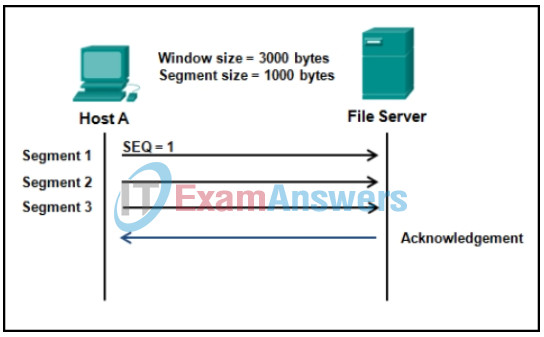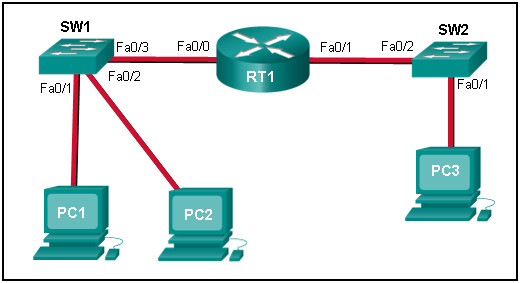Networking Devices and Initial Configuration Checkpoint Exam: ARP, DNS, DHCP and the Transport Layer Answers
1. What statement describes the function of the Address Resolution Protocol?
- ARP is used to discover the IP address of any host on the local network.
- ARP is used to discover the MAC address of any host on the local network.
- ARP is used to discover the MAC address of any host on a different network.
- ARP is used to discover the IP address of any host on a different network.
2. Refer to the exhibit. What does R1 use as the MAC address of the destination when constructing the frame that will go from R1 to Server B?

- If the destination MAC address that corresponds to the IPv4 address is not in the ARP cache, R1 sends an ARP request.
- The packet is encapsulated into a PPP frame, and R1 adds the PPP destination address to the frame.
- R1 leaves the field blank and forwards the data to the PC.
- R1 uses the destination MAC address of S1.
3. What is the protocol that is used to discover a physical address from a known logical address and what message type does it use?
- PING, broadcast
- DNS, unicast
- DNS, broadcast
- PING, multicast
- ARP, multicast
- ARP, broadcast
4. When a computer is pinging another computer for the first time, what type of message does it place on the network to determine the MAC address of the other device?
- a multicast to any Layer 3 devices that are connected to the local network
- an RFI (Request for Information) message
- an ARP request
- an ICMP ping
5. A user sends an HTTP request to a web server on a remote network. During encapsulation for this request, what information is added to the address field of a frame to indicate the destination?
- the IP address of the default gateway
- the MAC address of the destination host
- the network domain of the destination host
- the MAC address of the default gateway
6. Refer to the exhibit. When PC1 wants to send a packet to PC3, the IP address of the device that will respond to the ARP request is

Networking Devices and Initial Configuration Module 7 – 9 Checkpoint Exam Q6
- 192.168.1.2
- 192.168.1.254
- 192.168.0.1
- 192.168.0.3
- 192.168.0.2
- 192.168.0.254
- 192.168.1.1
7. What are two problems that can be caused by a large number of ARP request and reply messages? (Choose two.)
- The ARP request is sent as a broadcast, and will flood the entire subnet.
- The network may become overloaded because ARP reply messages have a very large payload due to the 48-bit MAC address and 32-bit IP address that they contain.
- Switches become overloaded because they concentrate all the traffic from the attached subnets.
- All ARP request messages must be processed by all nodes on the local network.
- A large number of ARP request and reply messages may slow down the switching process, leading the switch to make many changes in its MAC table.
8. A user reports that the corporate web server cannot be accessed. A technician verifies that the web server can be accessed by its IP address. What are two possible causes of the problem? (Choose two.)
- The network connection is down.
- The default gateway address is misconfigured on the workstation.
- The DNS server address is misconfigured on the workstation.
- The web server is misconfigured.
- The web server information is misconfigured on the DNS server.
9. Which DHCP IPv4 message contains the following information?
Destination address: 255.255.255.255
Client IPv4 address: 0.0.0.0
Default gateway address: 0.0.0.0
Subnet mask: 0.0.0.0
- DHCPREQUEST
- DHCPACK
- DHCPDISCOVER
- DHCPOFFER
10. Which two commands could be used to check if DNS name resolution is working properly on a Windows PC? (Choose two.)
- nbtstat cisco.com
- net cisco.com
- ping cisco.com
- ipconfig /flushdns
- nslookup cisco.com
11. Which three statements describe a DHCP Discover message? (Choose three.)
- Only the DHCP server receives the message.
- The message comes from a client seeking an IP address.
- The source MAC address is 48 ones (FF-FF-FF-FF-FF-FF).
- The message comes from a server offering an IP address.
- All hosts receive the message, but only a DHCP server replies.
- The destination IP address is 255.255.255.255.
12. What IPv4-related DNS record type is used by a DNS server in response to a host requesting for a web server address via the URL?
- NS record
- A record
- MX record
- AAAA record
13. Which two tasks can be performed by a local DNS server? (Choose two.)
- retrieving email messages
- providing IP addresses to local hosts
- mapping name-to-IP addresses for internal hosts
- forwarding name resolution requests between servers
- allowing data transfer between two network devices
14. A DHCP configured PC boots up. What is the order of the messages that are sent and received by this PC in order to obtain an appropriate IP address?
- DHCPOFFER, DHCPDISCOVER, DHCPREQUEST, DHCPACK
- DHCPDISCOVER, DHCPOFFER, DHCPREQUEST, DHCPACK
- DHCPDISCOVER, DHCPREQUEST, DHCPOFFER, DHCPACK
- DHCPREQUEST, DHCPOFFER, DHCPDISCOVER, DHCPACK
15. Refer to the exhibit. Host A and the file server have established a TCP session to exchange data. What acknowledgement number will the file server send to host A to acknowledge receipt of the first three segments of data?

Networking Devices and Initial Configuration Module 7 – 9 Checkpoint Exam Q15
- 3000
- 1002
- 3001
- 4000
- 1000
16. A host device needs to send a large video file across the network while providing data communication to other users. Which feature will allow different communication streams to occur at the same time, without having a single data stream using all available bandwidth?
- port numbers
- multiplexing
- acknowledgments
- window size
17. What does a client application select for a TCP or UDP source port number?
- a random value in the range of the registered ports
- a random value in the well-known port range
- a predefined value in the well-known port range
- a predefined value in the range of the registered ports
18. A client is establishing a TCP session with a server. How is the acknowledgment number in the response segment to the client determined?
- The acknowledgment number is set to 11 to signify an acknowledgment packet and synchronization packet back to the client.
- The acknowledgment number field uses a random source port number in response to the client.
- The acknowledgment number field is modified by adding 1 to the randomly chosen initial sequence number in response to the client.
- The acknowledgment number is set to 1 to signify an acknowledgment packet back to the client.
19. Which two TCP header fields are used to confirm receipt of data? (Choose two.)
- checksum
- acknowledgment number
- sequence number
- preamble
- FCS
20. What is a socket?
- the combination of the source and destination IP address and source and destination Ethernet address
- the combination of a source IP address and port number or a destination IP address and port number
- the combination of the source and destination sequence and acknowledgment numbers
- the combination of the source and destination sequence numbers and port numbers
21. What TCP mechanism is used to enhance performance by allowing a device to continuously send a steady stream of segments as long as the device is also receiving necessary acknowledgements?
- socket pair
- sliding window
- three-way handshake
- two-way handshake
22. Refer to the exhibit. PC1 issues an ARP request because it needs to send a packet to PC3. In this scenario, what will happen next?

- RT1 will send an ARP reply with its own Fa0/1 MAC address.
- SW1 will send an ARP reply with its Fa0/1 MAC address.
- RT1 will send an ARP reply with the PC3 MAC address.
- RT1 will forward the ARP request to PC3.
- RT1 will send an ARP reply with its own Fa0/0 MAC address.
23. Refer to the exhibit. What does the value of the window size specify?

- the amount of data that can be sent at one time
- the amount of data that can be sent before an acknowledgment is required
- the total number of bits received during this TCP session
- a random number that is used in establishing a connection with the 3-way handshake
